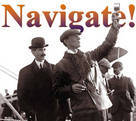|

 Up
Up 
 A Unique
A Unique
Opportunity 
(You are here.)
 Down
Down




  Need
to Need
to
find your
bearings?
Try
these
navigation aids:
If
this is your first
visit, please stop by:
Something
to share?
Please:



|
|
Available in Française, Español, Português, Deutsch, Россию,
中文,
日本, and others.
 n
1999, a group of pilots, historians, educators, and aviation
enthusiasts set out to recreate the "birth of aviation;" that is, to
build and fly the six experimental aircraft the Wright brothers
created in their quest for a practical flying machine. Our purpose
was education. We worked with young people to build these gliders
and airplanes, teaching them a little aeronautics, mathematics, and
aviation history as we did so. Our goal was that this adventure in
aviation archaeology would inspire our young participants to pursue
careers in science and engineering. And it worked. Just last year
one of our first students became an engineer at SpaceX, possibly the
most exciting and ambitious aerospace corporation on the planet. And
there are more on the way, young people who once built Wright
airplane parts in our workshop who will go on to build the amazing
technologies of the twenty-first century. n
1999, a group of pilots, historians, educators, and aviation
enthusiasts set out to recreate the "birth of aviation;" that is, to
build and fly the six experimental aircraft the Wright brothers
created in their quest for a practical flying machine. Our purpose
was education. We worked with young people to build these gliders
and airplanes, teaching them a little aeronautics, mathematics, and
aviation history as we did so. Our goal was that this adventure in
aviation archaeology would inspire our young participants to pursue
careers in science and engineering. And it worked. Just last year
one of our first students became an engineer at SpaceX, possibly the
most exciting and ambitious aerospace corporation on the planet. And
there are more on the way, young people who once built Wright
airplane parts in our workshop who will go on to build the amazing
technologies of the twenty-first century.
We are looking for a home in which to continue this work.
The Birth of Aviation Collection+
The airworthy replicas we have built with young people are the basis
of the Wright Brothers Aeroplane Company "Birth of Aviation"
collection, the world's first and only collection to include all of
the Wright brothers' experimental airplanes. Not even the Wright
brothers saw all of these aircraft in one place at one time! To these
aircraft
we added the Wright's wind tunnel and other scientific instruments,
their printing press, bicycle, flight simulators (for each
aircraft), and interactive displays. We even reproduced the 1878
Wright "Bat," a rubber band-powered model helicopter built
by the
brothers when Wilbur was 12 and Orville 8. It was their first
successful venture in aviation.
We first showed this collection in the "Birth of Aviation Pavilion"
at the 2003 Dayton Air Show. The airplanes, artifacts, simulators,
and displays were laid out in a walk- through timeline that allowed
visitors to see how the Wright brothers inventive ideas evolved
with each new aircraft until they at last achieved a practical
aircraft in 1905. The Birth of Aviation Pavilion was the central
static display at the Dayton air Show for three years, then we took
the collection on tour across North America. To date, all or part of
the collection has been displayed in 55 cities in the United States
and Canada, and we have visited many of those cities twice or more.
At the same time, we developed several educational programs
that you can read about on our
Exhibits & Programs page. One of the most popular is our
Secret of Flight school tour. This is a collection of
demonstrations and workshops that we have taken to schools from
Maine to Texas. It includes a "portable museum" of the Wright
brothers with a full-scale flying replica of the 1902 Wright Glider,
the world's first fully controllable aircraft. We have also
continued to develop our web site into a popular source of
information on pioneer aviation and basic aeronautics.
But every business (and non-profit business), however successful,
must adapt to change. New technological developments and financial
realities have closed some doors to us and opened others. Touring is
increasingly expensive, laborious, and hard on the airplanes. To
continue our educational mission, we need to place to set up our
extensive collection permanently and use it in conjunction with
webcasting technology to provide "virtual field trips" that are more
and more becoming part of the standard museum business model. We
also have some innovative ideas for web-based educational programs,
but these too require display and workshop space. Our present
facility offers space for storage only.
So we are looking for home that allows us to grow. If you have
one to offer, we are flexible enough to meet your needs as well. We
will consider a partnership with an existing museum or educational
institution. If you want to start a new museum, we will take an
active part in the planning and fund-raising. We will also consider
a straight sale of the airplanes and artifacts that affords us
enough funds to continue our educational mission. Look through this
web site, particularly the section on the
Birth of Aviation Exhibition. If you think that the WBAC's collection would be a worthwhile opportunity for your
community either to increase tourism or to provide educational
opportunities – or both – then please
get in touch.
|

WBAC's 1899 Wright experimental kite.

WBAC's 1900 Wright Glider.

WBAC's 1901 Wright Glider.

WBAC's 1902 Wright Glider.

WBAC's 1903 Wright Flyer I.

WBAC's 1905 Wright Flyer III.
|